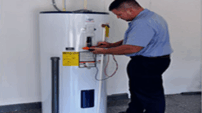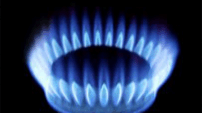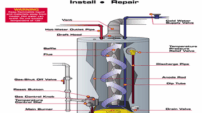Water Heater Service
Pipe Bros makes water heater service simple and clean! Our experienced plumbing professionals will respond quickly to get the hot water running in your home as soon as possible. Ask about our discounts and coupons available for water heater service. You may purchase a water heater from Pipe Bros or you may purchase one yourself from the supplier of your choice and we will be happy to install it for you. We recommend American made Bradford White water heaters to all of our customers because of its quality and durability however we will be able to purchase any brand for you that you request.
Water Heater Installation Process
Once our plumber arrives, he will greet you and will begin to inspect the water heater. He will run some basic tests and he will check to make sure the water heater is in compliance with current safety regulations. The plumber will then go over everything with you and will require a signature before he proceeds with the water heater installation.
A typical water heater installation will take between 2 and 4 hours depending on the amount of work that needs to be done.
Water Heater Life Expectancy
Conventional water heaters usually last about 10-15 years and tankless heaters have a life expectancy of 15-20 years, however hard water will shorten the life of any water heater but regular maintenance will prolong it. Ask your Pipe Bros plumbing professional how you can prolong the life of your new water heater.
Hot Water Heater Efficiency
If you have questions before you replace your old hot water heater, feel free to schedule an appointment with a Pipe Bros plumbing professional to asses your current water heater and he will be able to advise you on what type of water heater (either gas or electric) will best fit the needs of your family. Depending on the size of your home, the number of bathrooms and the number of people needing to use hot water on a daily basis, he will be able to tell you what size, brand and type will be the best option.
Tankless heaters are considered more energy efficient than conventional heaters because they don’t have to continually heat a tank of water because tankless heaters heat water instantly whenever a hot water tap is opened.
The Best Temperature for your Hot Water Heater
To reduce the risk of scalding and to avoid the risk of running out of hot water, Pipe Bros recommends a temperature setting of 120°-125° F.
Always remember to never store paints, solvents or combustibles near the water heater due to the risk of fire.
Various Sizes of Water Heaters
Both residential gas and electric water heaters come in a variety of sizes but the most common are:
- 30 gallon
- 40 gallon
- 50 gallon
- 75 gallon
- 100 gallon
The majority of homes have a 40 or 50 gallon tank with the 50 gallon tank being the most common. Larger homes with more bathrooms or homes that have a large soaking tub or Jacuzzi usually require a larger 75 gallon water heater.
Ask your Pipe Bros plumbing professional whether the size you currently have is the best option for your home. It is possible to replace your water heater with one that is a different size. When switching to a larger water heater, Pipe Bros will ensure that your entire system is installed safely and we will usually need to increase the size of the vent on gas water heaters.
Water Heater Warranty
Pipe Bros currently offers a warranty on all of our installations which includes:
1 year warranty on labor done by Pipe Bros
5-6 year Manufacturer’s Warranty on the Water Heater itself
All Water Heaters Installations Follow Current Plumbing Codes
Pipe Bros makes sure that your family is protected by safely installing every water heater and making sure everything is up to code. Water Heater safety includes:
- Earthquake strapping: In earthquake zones such as the state of California, your water heater must have approved earthquake straps installed to secure the water heater and help prevent severe damage and fire in the event of an earthquake. If approved straps are already installed, we can re-use them.
- Pressure and Temperature Relief Line: Depending on your location, you may be required to pipe your P&T relief line to an exterior or approved location. This is to prevent very hot water from scalding the resident.
- Expansion Tanks: Expansion tanks are required in some areas when your home is on what is called a “closed” water system. On a closed system, when water is heated, thermal expansion can cause rapid increases and decreases in system pressure which cause wear and tear on the tank and on all of your plumbing. An expansion tank prevents this from occurring and in many cases can even double the life of the water heater.
- Pan and drain: A water heater pan and drain are required to protect your drywall and wood foundation from water damage in case of a water heater leak.
- Adequate venting: Your water heater vents Carbon Monoxide (CO) and must be vented safely to prevent CO from leaking into your home. If the energy input on the new heater is greater than the old heater, we may need to upsize some portion of your venting. This is important for your safety.
- Stand: Although new water heaters have sealed combustion chambers, many cities still require that your water heater is elevated off of the ground. In many cases, the city has additional requirements around what type of material the stand may be made of. Most of our water heaters are “FVIR” or flammable vapor ignition resistant, which technically does not need to be put on a stand. Many cities are still learning about these new, safer heaters and still require us to elevate your tank.
- Drip leg: Many manufacturers require that we place a sediment trap or drip leg on the gas line into the water heater as close to the inlet as possible. This is to prevent moisture and debris from entering the firing chamber of the water heater.
- Bollard or barrier: If your gas water heater is in the direct path of a car, you may be required to install a barrier or bollard between the garage and the water heater. The barrier is meant to prevent a moving vehicle from knocking the heater over and worse, severing the gas line.
Gas Water Heaters
- Adequate venting: Your water heater vents Carbon Monoxide (CO) and must be vented safely to prevent CO from leaking into your home. If the energy input on the new heater is greater than the old heater, we may need to upsize some portion of your venting. This is important for your safety.
- Stand: Although new water heaters have sealed combustion chambers, many cities still require that your water heater is elevated off of the ground. In many cases, the city has additional requirements around what type of material the stand may be made of. Most of our water heaters are “FVIR” or flammable vapor ignition resistant, which technically does not need to be put on a stand. Many cities are still learning about these new, safer heaters and still require us to elevate your tank.
- Drip leg: Many manufacturers require that we place a sediment trap or drip leg on the gas line into the water heater as close to the inlet as possible. This is to prevent moisture and debris from entering the firing chamber of the water heater.
- Bollard or barrier: If your gas water heater is in the direct path of a car, you may be required to install a barrier or bollard between the garage and the water heater. The barrier is meant to prevent a moving vehicle from knocking the heater over and worse, severing the gas line.
Call Pipe Bros Today for a Water Heater Replacement!
Call now! 1-855-PIPE-BROS or 1-855-747-3276
Pipe Bros has plumbing professionals ready to service your water heater as soon as you call and get your hot water up and running again.
Call us Today at 1-855-PIPE BROS or 1-855-747-3276




